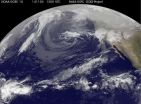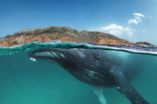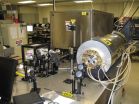(Press-News.org) VIDEO:
A new time-lapse animation of data from NOAA's GOES-West satellite provides a good picture of why the U.S. West Coast continues to experience record rainfall. The new animation shows the...
Click here for more information.
A new time-lapse animation of data from NOAA's GOES-West satellite provides a good picture of why the U.S. West Coast continues to experience record rainfall. The new animation shows the movement of storms from Nov. 30 to Dec. 3.
NOAA's Geostationary Operational Environmental Satellites or GOES-West imagery from Nov. 30 to Dec. 3 was compiled into a 36 second video made by NASA/NOAA's GOES Project at NASA's Goddard Space Flight Center in Greenbelt, Maryland.
The video shows a low pressure system several hundred miles west of California on Nov. 30. South of the center of the low, a large stream of moisture from the Pacific Ocean was swept up and transported east over the southern part of the state and Baja California, Mexico. Over the course of Dec. 1, 2 and 3 as the low approached the coast the stream of moisture merged with the low, bringing more rains to southern California on Dec. 3.
Water managers are not calling the storm that dropped several inches of rain onto Southern California on Tuesday, Dec. 2, a drought-buster, and climate scientists are not labeling it an El Niño event.
Bill Patzert, climatologist at NASA's Jet Propulsion Laboratory in Pasadena, California who studies ocean patterns, said "scientists have not yet declared an El Niño, and if they do, it would be weak and not necessarily bring torrential rains like in 1997 through 1998, the year that super El Niño' storms drenched Southern California."
Patzert called the storm a pineapple express of tropical origin that met up with a low-pressure system off the coast. "It is warmer moisture - like a fire hose aimed at us from the south of Hawaii," Patzert said. "This is an event. It is not a pattern."
According to the National Weather Service office in Los Angeles, rainfall on Dec. 2 in downtown Los Angeles was 1.21 inches, setting a new record for that date. The previous record was 1.10 inches that fell in 1961. The Los Angeles International Airport recorded a record-breaking 1.12 inches of rainfall on Dec. 2, beating the 1966 record of 0.73 inches.
In Santa Barbara even more rain fell, where a record-breaking total measured was 2.14 inches on Dec. 2. The old record was set in 1966 when 2.12 inches of rain fell. Records were also set on Dec. 2 in Lancaster Fox Field, Calif. with 1.14 inches of rain, Sandberg with 1.49 inches, Palmdale with 1.20 inches, and the Long Beach Airport with 1.04 inches. Further south at Fullerton Airport, a record-setting 0.58 inches fell on Dec. 2.
There is some good news from the rainfall. Patzert pointed to the wetter chaparral in the Southern California foothills "tamping down the prospect of extreme wildfires when the Santa Ana winds are expected to return shortly." He also pointed up north to snow falling in the Sierra Nevada. Snowpack in that region is where the state gets 95 percent of its water. .
To create the video and imagery, NASA/NOAA's GOES Project takes the cloud data from NOAA's GOES-East satellite and overlays it on a true-color image of land and ocean created by data from the Moderate Resolution Imaging Spectroradiometer, or MODIS, instrument that flies aboard NASA's Aqua and Terra satellites. Together, those data created the entire picture of the storm and show its movement. After the storm system passes, the snow on the ground becomes visible.
GOES satellites provide the kind of continuous monitoring necessary for intensive data analysis. Geostationary describes an orbit in which a satellite is always in the same position with respect to the rotating Earth. This allows GOES to hover continuously over one position on Earth's surface, appearing stationary. As a result, GOES provide a constant vigil for the atmospheric "triggers" for severe weather conditions such as tornadoes, flash floods, hail storms and hurricanes.
INFORMATION:
For updated information about the storm system, visit NOAA's NWS website: http://www.weather.gov
For more information about GOES satellites, visit: http://www.goes.noaa.gov/ or goes.gsfc.nasa.gov/
Rob Gutro
NASA's Goddard Space Flight Center
PITTSBURGH, Dec. 3, 2014 - Sophisticated lung imaging can show whether or not a treatment drug is able to clear tuberculosis (TB) lung infection in human and macaque studies, according to researchers at the University of Pittsburgh School of Medicine and their international collaborators.
The findings, published online today in Science Translational Medicine, indicate the animal model can correctly predict which experimental agents have the best chance for success in human trials.
The image on the left shows "hot spots" of infection in a patient's lungs before treatment. ...
Scientists from WCS (Wildlife Conservation Society), the American Museum of Natural History (AMNH), the Environment Society of Oman, and other organizations have made a fascinating discovery in the northern Indian Ocean: humpback whales inhabiting the Arabian Sea are the most genetically distinct humpback whales in the world and may be the most isolated whale population on earth. The results suggest they have remained separate from other humpback whale populations for perhaps 70,000 years, extremely unusual in a species famed for long distance migrations.
The study appears ...
PULLMAN, Wash. - Sitting on an exam table in a flimsy gown can intimidate anyone. If you also happen to be lesbian, gay or bisexual, the experience can be even worse.
As a woman of sexual minority, Nicole Flemmer has encountered medical misinformation and false assumptions. She was once diagnosed with "ego dystonic homosexuality" - a long-discredited term - without her knowledge or an appropriate discussion with the doctor. She discovered the notation years later when she happened to glance at her medical chart.
Such experiences left her hesitant to access health ...
WEST LAFAYETTE, Ind. - A neurotoxin called acrolein found in tobacco smoke that is thought to increase pain in people with spinal cord injury has now been shown to accumulate in mice exposed to the equivalent of 12 cigarettes daily over a short time period.
One implication is that if acrolein is exacerbating pain its concentration in the body could be reduced using the drug hydralazine, which has been approved by the U.S. Food and Drug Administration for hypertension, said Riyi Shi (pronounced Ree Shee), a professor in Purdue University's Department of Basic Medical Sciences, ...
DURHAM, N.C. -- Citizens who get involved in science become more environmentally aware and willing to participate in advocacy than previously thought, according to a new study by researchers at Duke University's Nicholas School of the Environment. Citizen science projects can lead to broader public support for conservation efforts.
The study, led by PhD student McKenzie Johnson, appeared in November in the journal Global Environmental Change. It surveyed 115 people who had recently participated in citizen science projects in India with the Wildlife Conservation Society ...
An enzyme that usually triggers strong allergic reactions now circulates in the veins of a group of mice without alerting the immune system. As INRS Énergie Matériaux Télécommunications Research Centre Professor Marc A. Gauthier explains in an article published in the journal Nature Communications, a polymer was used to camouflage the enzyme before it was injected into the rodents. This was achieved by coating the enzyme to avoid an immune response in a manner that does not compromise its activity. The first in vivo demonstration has opened the door ...
DURHAM, N.C. -- Scientists have developed a way to sniff out tiny amounts of toxic gases -- a whiff of nerve gas, for example, or a hint of a chemical spill -- from up to one kilometer away.
The new technology can discriminate one type of gas from another with greater specificity than most remote sensors -- even in complex mixtures of similar chemicals -- and under normal atmospheric pressure, something that wasn't thought possible before.
The researchers say the technique could be used to test for radioactive byproducts from nuclear accidents or arms control treaty ...
Alcohol use is a major risk factor for head and neck cancer. But an article published in the November issue of the journal Advances in Experimental Medicine and Biology shows that the chemical resveratrol found in grape skins and in red wine may prevent cancer as well.
"Alcohol bombards your genes. Your body has ways to repair this damage, but with enough alcohol eventually some damage isn't fixed. That's why excessive alcohol use is a factor in head and neck cancer. Now, resveratrol challenges these cells - the ones with unrepaired DNA damage are killed, so they can't ...
West Orange, NJ. December 3, 2014. Brain injury researchers in New Jersey have identified retrieval practice as a useful strategy for improving memory among children and adolescents with traumatic brain injury (TBI). "Retrieval Practice as an Effective Memory Strategy in Children and Adolescents with TBI" (DOI: http://dx.doi.org/10.1016/j.apmr.2014.09.022) was published online ahead of print on October 10 by the Archives of Physical Medicine & Rehabilitation. This article is based on a collaborative study funded by Kessler Foundation and Children's Specialized Hospital. ...
As the two foolish pigs learned before running to their brother's solidly built house of bricks for safety, when the wolf comes calling, the quality of your shelter is everything.
Animals in the wild have always instinctively known this. But changes to their habitat in the wake of human encroachment, climate change and a variety of environmental influences are affecting the predator-prey relationship and creating new "fearscapes" dotted with predation risks.
To better understand what's happening, researchers are using innovative imaging techniques to map the properties ...





